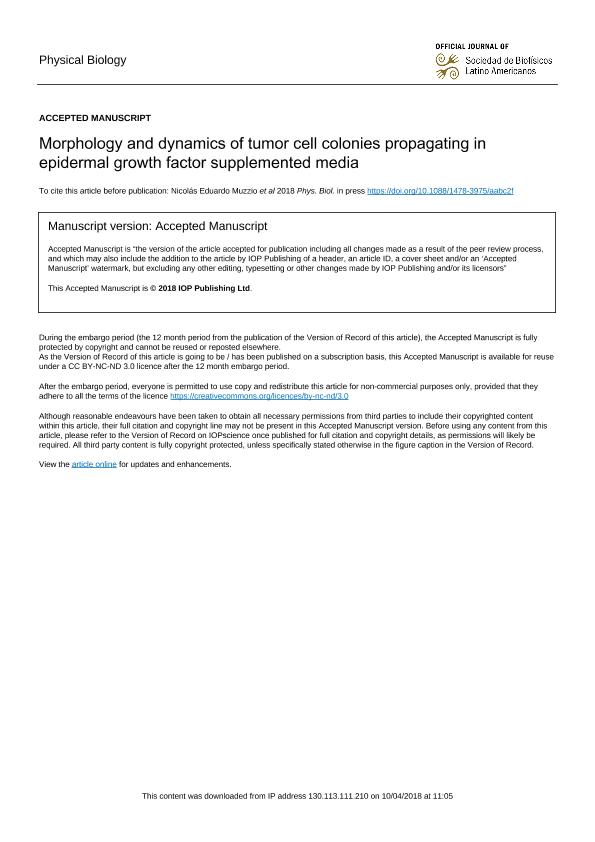Artículo
Morphology and dynamics of tumor cell colonies propagating in epidermal growth factor supplemented media
Muzzio, Nicolás Eduardo ; Carballido, Marcos; Pasquale, Miguel Angel
; Carballido, Marcos; Pasquale, Miguel Angel ; González, Pedro Horacio; Azzaroni, Omar
; González, Pedro Horacio; Azzaroni, Omar ; Arvía, Alejandro Jorge
; Arvía, Alejandro Jorge
 ; Carballido, Marcos; Pasquale, Miguel Angel
; Carballido, Marcos; Pasquale, Miguel Angel ; González, Pedro Horacio; Azzaroni, Omar
; González, Pedro Horacio; Azzaroni, Omar ; Arvía, Alejandro Jorge
; Arvía, Alejandro Jorge
Fecha de publicación:
30/04/2018
Editorial:
IOP Publishing
Revista:
Physical Biology
ISSN:
1478-3967
Idioma:
Inglés
Tipo de recurso:
Artículo publicado
Clasificación temática:
Resumen
The epidermal growth factor (EGF) plays a key role in physiological and pathological processes. This work reports on the influence of EGF concentration (c EGF) on the modulation of individual cell phenotype and cell colony kinetics with the aim of perturbing the colony front roughness fluctuations. For this purpose, HeLa cell colonies that remain confluent along the whole expansion process with initial quasi-radial geometry and different initial cell populations, as well as colonies with initial quasi-linear geometry and large cell population, are employed. Cell size and morphology as well as its adhesive characteristics depend on c EGF. Quasi-radial colonies (QRC) expansion kinetics in EGF-containing medium exhibits a complex behavior. Namely, at the first stages of growth, the average QRC radius evolution can be described by a t 1/2 diffusion term coupled with exponential growth kinetics up to a critical time, and afterwards a growth regime approaching constant velocity. The extension of each regime depends on c EGF and colony history. In the presence of EGF, the initial expansion of quasi-linear colonies (QLCs) also exhibits morphological changes at both the cell and the colony levels. In these cases, the cell density at the colony border region becomes smaller than in the absence of EGF and consequently, the extension of the effective rim where cell duplication and motility contribute to the colony expansion increases. QLC front displacement velocity increases with c EGF up to a maximum value in the 2-10 ng ml-1 range. Individual cell velocity is increased by EGF, and an enhancement in both the persistence and the ballistic characteristics of cell trajectories can be distinguished. For an intermediate c EGF, collective cell displacements contribute to the roughening of the colony contours. This global dynamics becomes compatible with the standard Kardar-Parisi-Zhang growth model, although a faster colony roughness saturation in EGF-containing medium than in the control medium is observed.
Palabras clave:
EPIDERMAL GROWTH FACTOR
,
HELA CELL
,
COLONY KINETICS
,
DYNAMIC SCALING
Archivos asociados
Licencia
Identificadores
Colecciones
Articulos(IFIBA)
Articulos de INST.DE FISICA DE BUENOS AIRES
Articulos de INST.DE FISICA DE BUENOS AIRES
Articulos(INIFTA)
Articulos de INST.DE INV.FISICOQUIMICAS TEORICAS Y APLIC.
Articulos de INST.DE INV.FISICOQUIMICAS TEORICAS Y APLIC.
Citación
Muzzio, Nicolás Eduardo; Carballido, Marcos; Pasquale, Miguel Angel; González, Pedro Horacio; Azzaroni, Omar; et al.; Morphology and dynamics of tumor cell colonies propagating in epidermal growth factor supplemented media; IOP Publishing; Physical Biology; 15; 4; 30-4-2018
Compartir



